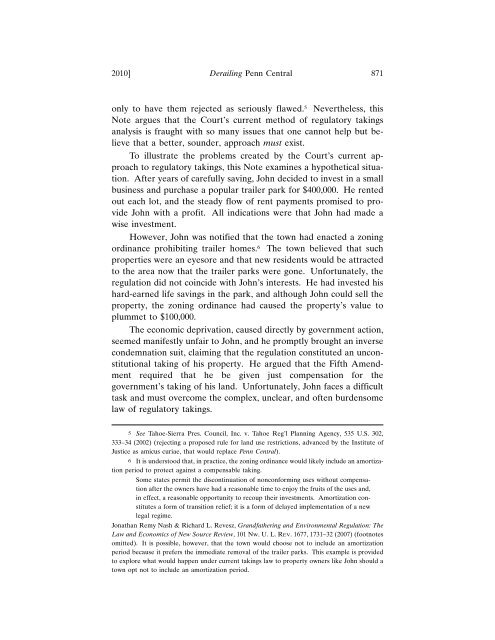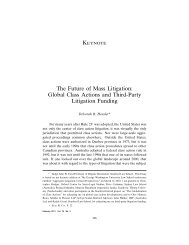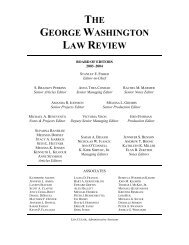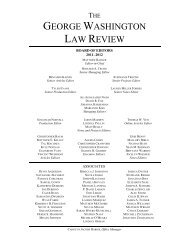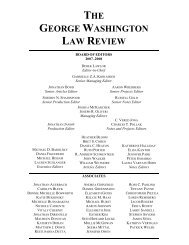View PDF - The George Washington Law Review
View PDF - The George Washington Law Review
View PDF - The George Washington Law Review
Create successful ePaper yourself
Turn your PDF publications into a flip-book with our unique Google optimized e-Paper software.
2010] Derailing Penn Central 871<br />
only to have them rejected as seriously flawed. 5 Nevertheless, this<br />
Note argues that the Court’s current method of regulatory takings<br />
analysis is fraught with so many issues that one cannot help but believe<br />
that a better, sounder, approach must exist.<br />
To illustrate the problems created by the Court’s current approach<br />
to regulatory takings, this Note examines a hypothetical situation.<br />
After years of carefully saving, John decided to invest in a small<br />
business and purchase a popular trailer park for $400,000. He rented<br />
out each lot, and the steady flow of rent payments promised to provide<br />
John with a profit. All indications were that John had made a<br />
wise investment.<br />
However, John was notified that the town had enacted a zoning<br />
ordinance prohibiting trailer homes. 6 <strong>The</strong> town believed that such<br />
properties were an eyesore and that new residents would be attracted<br />
to the area now that the trailer parks were gone. Unfortunately, the<br />
regulation did not coincide with John’s interests. He had invested his<br />
hard-earned life savings in the park, and although John could sell the<br />
property, the zoning ordinance had caused the property’s value to<br />
plummet to $100,000.<br />
<strong>The</strong> economic deprivation, caused directly by government action,<br />
seemed manifestly unfair to John, and he promptly brought an inverse<br />
condemnation suit, claiming that the regulation constituted an unconstitutional<br />
taking of his property. He argued that the Fifth Amendment<br />
required that he be given just compensation for the<br />
government’s taking of his land. Unfortunately, John faces a difficult<br />
task and must overcome the complex, unclear, and often burdensome<br />
law of regulatory takings.<br />
5 See Tahoe-Sierra Pres. Council, Inc. v. Tahoe Reg’l Planning Agency, 535 U.S. 302,<br />
333–34 (2002) (rejecting a proposed rule for land use restrictions, advanced by the Institute of<br />
Justice as amicus curiae, that would replace Penn Central).<br />
6 It is understood that, in practice, the zoning ordinance would likely include an amortization<br />
period to protect against a compensable taking.<br />
Some states permit the discontinuation of nonconforming uses without compensation<br />
after the owners have had a reasonable time to enjoy the fruits of the uses and,<br />
in effect, a reasonable opportunity to recoup their investments. Amortization constitutes<br />
a form of transition relief; it is a form of delayed implementation of a new<br />
legal regime.<br />
Jonathan Remy Nash & Richard L. Revesz, Grandfathering and Environmental Regulation: <strong>The</strong><br />
<strong>Law</strong> and Economics of New Source <strong>Review</strong>, 101 NW. U. L. REV. 1677, 1731–32 (2007) (footnotes<br />
omitted). It is possible, however, that the town would choose not to include an amortization<br />
period because it prefers the immediate removal of the trailer parks. This example is provided<br />
to explore what would happen under current takings law to property owners like John should a<br />
town opt not to include an amortization period.


